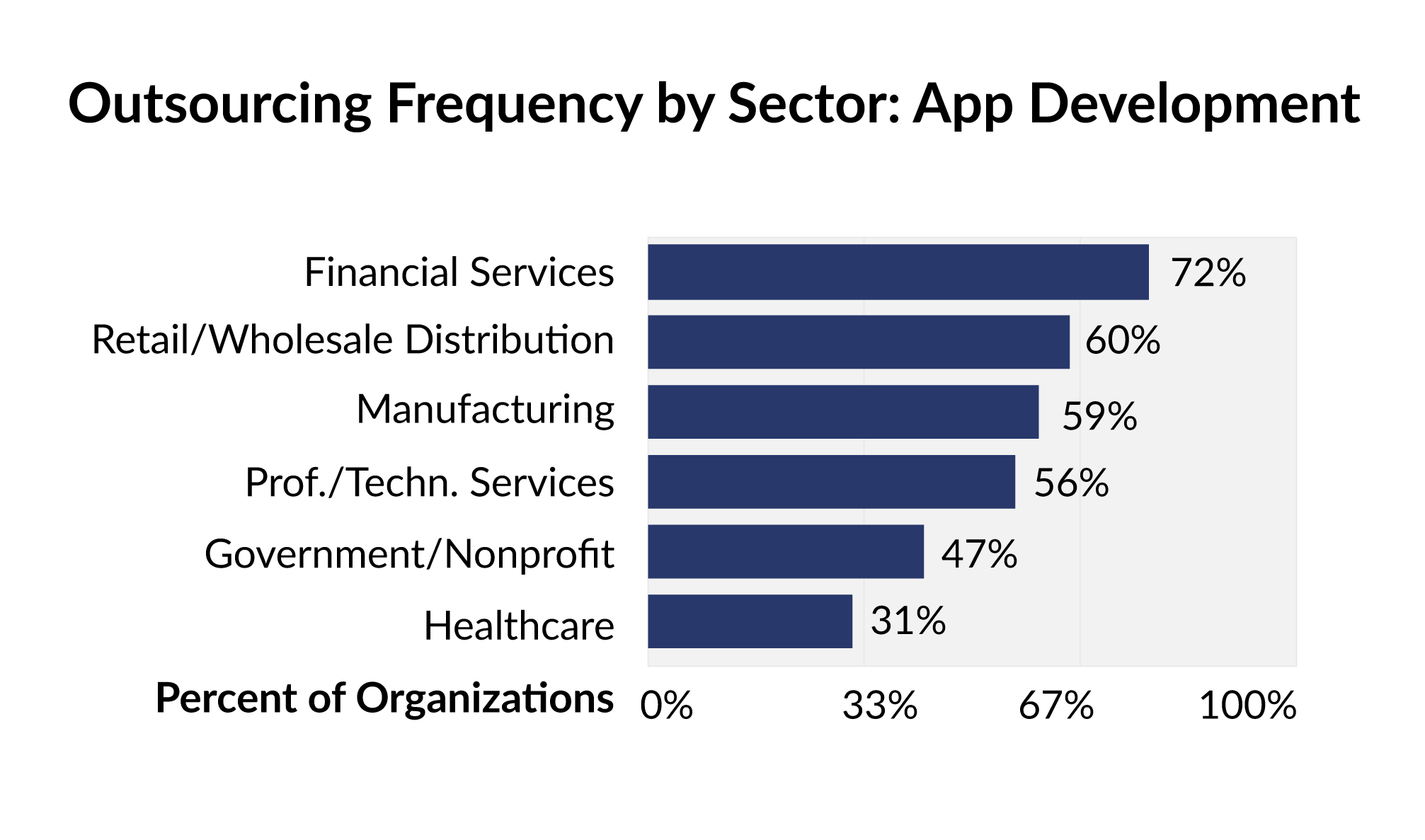Software development was one of the first sectors to adopt talent outsourcing during the first phases of industry globalization. In 2021, outsourcing as a percentage of companies’ IT budgets rose to the highest rate in more than 10 years. Approximately 60% of companies in the US and Canada outsource software app development. Financial Services tops the list of sectors outsourcing app development.

Outsourcing can cut labor costs, help smaller firms compete with larger ones, and leverage time zones to create a 24/7 development cycle. Remote outsourced software development teams aren’t always a perfect solution, though. Communicating successfully with a development team made up of in-house and outsourced talent requires preplanning, structured workflows, empathy, and flexible management styles. Read more on whether to proceed with team augmentation vs. outsourcing for your software development needs.
Firms across all sectors are facing a global labor shortage for programming talent. To win the competition for the best talent, companies can create communication strategies to support the team experience, performance, and success.
Check out our tips below for improving communication with an outsourced developer team.
To win the competition for the best talent, companies can create communication strategies to support the team experience, performance, and success. Click To TweetHow Hiring Affects Remote Development Team Communication
The seeds of team success start in the hiring process. Experienced team leaders stress the importance of carefully interviewing providers and talent to determine the best fit for your expectations, project, and company culture. When hiring people from other countries, you are also engaging with different languages and cultures, and holiday or time off expectations.
Avoid tension between in-house or veteran employees and outsourced talent. Be clear about the chain of command and set clear boundaries for tasks.
Be clear about expectations and ask for buy-in from each team member. After that, don’t micromanage. Use regular reporting intervals and gather metrics to evaluate performance and identify potential gaps, red flags, or stuck areas.
Cultural Considerations for Outsourced Team Communication
North American communication styles are very direct, especially in the United States. Americans see this as normal and efficient, yet this casual directness may be intimidating to others. The way to manage being direct is to adopt a respectful tone, affirm the other person’s presence, and double-check for understanding. Giving kudos goes a long way, too.
In some cultures, people avoid asking questions because they don’t want to let anyone down. Build trust with your team so that members know it's OK to ask questions or admit something is not clear.
Humor also varies across individuals and cultures. Do some research ahead of time to avoid offensive words, phrases, and even hand gestures. What people consider appropriate in some cultures may not be appreciated as funny in other settings.
Communicating Expectations and Workflow for Outsourced Teams
Depending on where your team lives, they may collaborate and hand off the day’s work to the next person in the other time zone, effectively creating an almost 24/7 development workday.
The challenge to this cycle is that if someone has a question and the manager is sound asleep on the other side of the planet, that day’s work may stall.
Many companies find the sweet spot is outsourcing talent in the same hemisphere. For example, Sharkbyte’s team members all reside in the US and Canada, with the added benefit of no language barriers.
As far as evaluation goes, quantifiable metrics can take the guesswork out of interpretation. When setting up the project expectations, create instructions, tech specifications, any applicable manuals, and business logic. Be clear about guidelines for test schedules and reporting expectations. Appointing a dedicated team manager is essential to communicating efficiently.
Develop a timeline for each part of the project that includes some padding for unexpected events and holidays in other countries. Using visuals is very helpful, especially if there are language barriers.
Be sure to include software architectural details, such as scope, program source code, descriptions of each element, and integration with existing platforms.
Even with options to get work done across time zones, it is best to avoid an “always on” mentality. You can help your team maximize productivity no matter where they live by choosing the correct communication tools.
Communication Tools for Outsourced Teams
The explosion of outsourcing spurred a proliferation of communication tools, too. The challenge for managers is not finding the right tool for the job, it is limiting tools so that your team is not channel hopping, distracted, and wasting time in the overlapping thread.
Remote teams need tools for issue tracking, chats, documentation, and daily standups.
Keep in mind freelance developers may be working on multiple projects with different clients. The fewer channels they need to navigate, the more efficient they can be.
Asynchronous communication tools are ideal for remote teams. Async communication happens when people don’t need to be in the conversation at the same time. Today’s tools create trackable threads and allow for multiple conversations at once, without the in-person (or synchronous) effect of everyone talking at once.
Video messaging is becoming increasingly popular, too, although it works best with teams with a single shared language in areas with robust internet access.
Consistent expectations for checking in are helpful, too. Create a standard place and procedure for detailed notes so that the thread is easy to access and review.
Some chat tools, such as Slack, are used in live conversations and can also be used as an async channel, too. Team members check a message and respond during their shift, hours after their co-worker posted it.
The Bottom Line
Success with outsourced projects rests on the same foundation for any successful project - clear direction, supporting the team with the right tools, and empathy for different members’ situations. With remote teams, managers need to juggle additional communication and cultural differences. Time zones and language differences can magnify those challenges. Many companies find it easier to work with consultants that provide the team, rather than deal with individual freelancers. Contact us to learn more about Sharkbyte’s team augmentation services today.
Checklist for Communication Success with Outsourced Developers
- Spend time on interviews for the best match.
- Pay attention to cultural differences.
- Leverage time zone differences to everyone’s advantage.
- Adopt a respectful tone in communications.
- Build trust so everyone feels comfortable speaking up.
- Establish a clear hierarchy and division of responsibility with in-house and outsourced talent.
- Research and take note of cultural minefields around humor, words, and even gestures.
- Be clear about expectations, timeline, and workflow.
- Create consistent communication channels and check-ins.
- Provide clear written materials and visuals for project definition.
- Choose effective asynchronous tools.
Carefully weigh the trade-offs of lowest hourly rates vs. costs due to project friction from language barriers and time zone differences. Hiring English-speaking developers in your same time zone may save you time and money in the long run.



